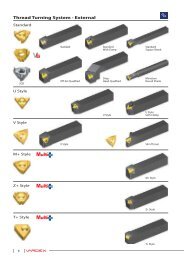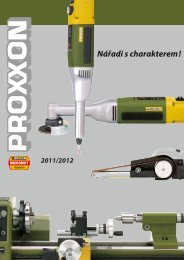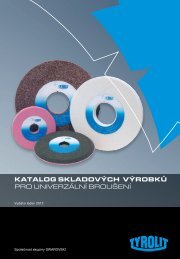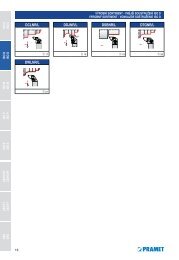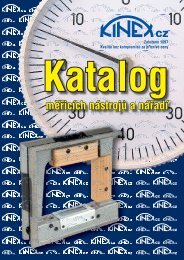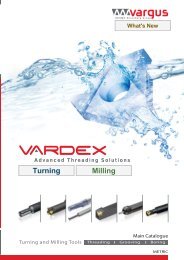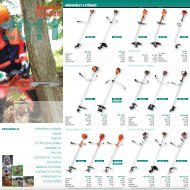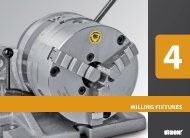Norton Industrial Catalog 7362 2011.indd
Norton Industrial Catalog 7362 2011.indd
Norton Industrial Catalog 7362 2011.indd
Create successful ePaper yourself
Turn your PDF publications into a flip-book with our unique Google optimized e-Paper software.
VITRIFIED WHEELS<br />
TROUBLESHOOTING GUIDE<br />
Check the obvious first. Before changing the grinding wheel specification, investigate the following most common causes for most grinding problems:<br />
1. Diamond dressing tool condition (check if worn or dull, rotate tool or replace if necessary)<br />
2. Coolant direction, volume and filtration<br />
3. Wheel dressing procedures (dress more open to free up cut rate, dress more closed to improve finish)<br />
PROBLEM POSSIBLE CAUSE CORRECTION<br />
Workpiece burn Poor coolant direction Redirect coolant into grinding zone<br />
Restricted or low coolant volume<br />
Increase coolant volume<br />
Wheel too hard<br />
Use one grade softer wheel<br />
Wheel structure too closed<br />
Use porous bond wheel<br />
Wheel dressed too fine<br />
Dress wheel coarser, more “open”<br />
Worn dressing tool<br />
Inspect, rotate or replace dressing tool<br />
Work speed too slow<br />
Increase work speed<br />
Infeed too fast<br />
Reduce stock removed per pass or upgrade to 5SG or 5NQ<br />
Wheel loading and glazing Wheel too fine Use coarser grit or softer grade wheel<br />
Wheel too hard<br />
Use one grade softer wheel<br />
Too durable abrasive<br />
Use a sharper, more friable abrasive<br />
Poor coolant quality<br />
Change coolant or use high detergent type<br />
Wheel structure too closed<br />
Use a porous bond wheel<br />
Wheel too finely dressed<br />
Dress wheel very open<br />
Diamond dressing tool worn<br />
Replace diamond and dress coarse (open)<br />
Depth of cut too small<br />
Increase feed and traverse speed<br />
Chatter Unsupported work Increase work support<br />
Machine vibration<br />
Check for worn bearings<br />
Too heavy cut rate<br />
Reduce cut rate<br />
Wheel too hard<br />
Use one grade softer wheel<br />
Wheel structure too closed<br />
Use a porous bond wheel<br />
Wheel out of balance<br />
Check wheel balance or try new wheel<br />
Chatter marks on workpiece Worn spindle bearings Check and correct for truth and end play<br />
Wheel out of truth<br />
Redress wheel and check mounting<br />
Poorly clamped wheel<br />
Check tightness of mounting nuts<br />
Glazed face of wheel<br />
Redress wheel with sharp dressing tool<br />
Poor surface finish Incorrect wheel dress Dress wheel finer (slow down dressing tool traverse)<br />
Worn dressing tool<br />
Inspect, rotate, or replace dressing tool<br />
Too coarse grit size<br />
Use a finer grit size<br />
Wheel too hard<br />
Use softer grade<br />
Not holding form Wheel too soft Use one grade harder wheel<br />
Wheel structure too open<br />
Use a more closed wheel structure<br />
Not holding corner Incorrect wheel dress Dress wheel finer. Face and side true wheel<br />
Too large grit size<br />
Use smaller grit size (maximum grit diameter less than 1.5 times<br />
corner radius)<br />
Wheel too soft<br />
Use harder grade wheel<br />
Wheel structure too open<br />
Use more closed structure wheel<br />
WHEEL DRESSING<br />
SINGLE POINT DIAMOND TOOLS<br />
• Rigidly mount Single Point tools at a<br />
10°-15° angle to the wheel centerline<br />
with a line drawn through the center<br />
of the wheel, pointing in the direction<br />
of wheel travel.<br />
• Point of contact should be slightly<br />
below centerline of wheel.<br />
• Use coolant whenever possible.<br />
• Normal infeed is .001" per pass.<br />
• Lead selections range from .002" -<br />
.010" per wheel revolution.<br />
• Rotate the tool 1/4 turn periodically to<br />
maintain a sharp point.<br />
It is the user’s responsibility to refer to and comply with ANSI B7.1<br />
MULTI-POINT DIAMOND TOOLS<br />
• Most multi-point tools are used for<br />
straight face dressing.<br />
• Tool should have full face contact with<br />
the wheel.<br />
• With new tool, 3 to 5 passes at .005"<br />
per pass should be taken to expose<br />
diamonds.<br />
• Infeed per pass .001" - .002"<br />
• Use coolant whenever possible.<br />
• Use appropriate lead (and traverse<br />
rate).<br />
• Contact your <strong>Norton</strong> representative<br />
for proper tool selection for Targa<br />
wheels.<br />
DRESSING CERAMIC WHEELS<br />
• Use our specially designed <strong>Norton</strong> SG diamond tools<br />
when dressing ceramic wheels.<br />
• When first using a <strong>Norton</strong> SG tool, make 3 to 5 passes<br />
at .005" infeed to ensure full face contact between the<br />
dressing tool and wheel face.<br />
• Reduce normal dressing infeed by half. Do not exceed<br />
infeed of .002" per pass.<br />
• The lead selection should be between .006" - .030" per<br />
wheel revolution. Faster traverse with <strong>Norton</strong> SG tools<br />
generally provides an open wheel face that can<br />
maximize productivity of the ceramic abrasive.<br />
To optimize applications using ceramic abrasives and/or<br />
tools, normal dressing parameters must change. Reduce<br />
infeed by 25%. Significant reductions in the amount of<br />
infeed and frequency of dress will result in substantially<br />
lower cost per part ground.<br />
See the Fliesen Tool section for new Furioso tools,<br />
engineered specifically for Quantum vitrified wheel<br />
dressing.<br />
210 NORTON – THE MUSCLE BEHIND THE MACHINE





